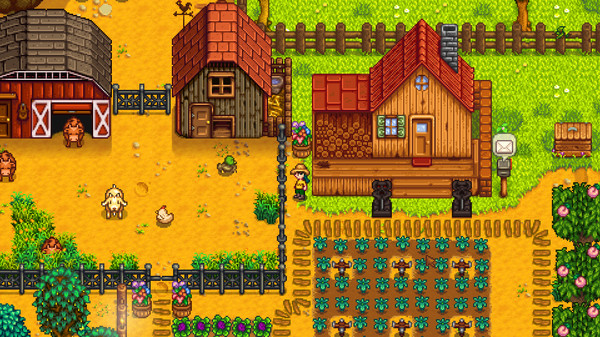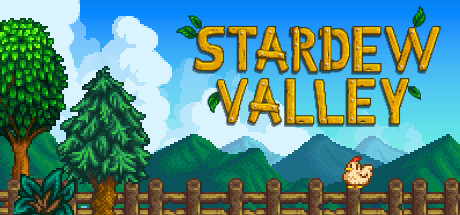Blog Archives
Stardew Valley Review
The recently released Stardew Valley has skyrocketed up the Steam sales charts since its launch, with the pixel art farming sim selling an immense number of copies (nearly 500,000 at the time of writing) in barely 2 weeks. This is one of the fastest selling indie games I’ve ever experienced, and I am glad to have been able to play this amazing game.
Inspired by the popular life-simulation series Harvest Moon, Stardew Valley is a farming and life simulator, where at the beginning of the game your grandfather passes on his failing farm in the picturesque Pelican Town. Starting with only a small amount of money, you must work to build your farm up from a run-down, weed infested plot of land into a prosperous business, while simultaneously befriending the townsfolk, restoring the town to it’s former glory, and finding a spouse.
 While at first glance, it may seem like the only thing to do in this game is farming, there are actually a host of different activities available to help you earn money. Along with the standard growing crops and raising animals, you can also fish, forage or explore the deep and dangerous mines where you can either mine precious gems and ores, or fight dangerous monsters for loot that they drop. All of these activities are viable ways of both making money as well as spending time while you wait for your farm to begin turning a profit.
While at first glance, it may seem like the only thing to do in this game is farming, there are actually a host of different activities available to help you earn money. Along with the standard growing crops and raising animals, you can also fish, forage or explore the deep and dangerous mines where you can either mine precious gems and ores, or fight dangerous monsters for loot that they drop. All of these activities are viable ways of both making money as well as spending time while you wait for your farm to begin turning a profit.
Obviously, farming is the primary method of earning money (it is a farming game after all) and the mechanics presented in this game are very solid. Drawing heavy inspiration from Harvest Moon: Friends of Mineral Town on the Game boy Advance,(which was also my first Harvest Moon Game) with it’s pixel art and design, it takes all of the best parts of that game, and combines it with some great updates, mainly sprinklers, items you can craft which will water your plants for you, to help you save time and allow you to further explore the town.
Pelican Town itself is filled with a large number of colourful characters, each with their own likes and dislikes, and their own day to day schedules. You can attempt to befriend them by giving them gifts and talking to them daily, and occasionally they will post quests on the town notice board, asking you to fetch them some items in exchange for a friendship boost. Achieving higher friendship levels with the townsfolk will lead to them sometimes sending you useful items, or recipes that you can use to cook high quality food. There is also 10 spouse choices in this game, each with radically different personalities and interests, and, in a break from Harvest Moon tradition, same-sex marriage is included in this game, allowing you to romance all 10 of these characters in order to find your perfect match.
Fans of Harvest Moon and other life simulators and farming games will definitely enjoy this game, especially if you enjoyed Friends of Mineral Town, a very similar game. I highly recommend this game to everyone interested in this sort of game, and even those who haven’t tried a similar game before to try this one out. It’s relatively cheap, and amazing fun, and at the time of writing this, I have over 40 hours invested in less than one week of owning it.
Not Quite Retro Review: Harvest Moon: A Wonderful Life
One of my favorite games is Natsume and Marvelous Entertainment’s 2004 game, Harvest Moon: A Wonderful Life. And I don’t really know why. The principle sounds like the most boring thing ever, yet it is insanely addictive and enjoyable.
I don’t know why I actually got this game, as the premise of it seemed utterly boring. You play as a man (fan-named Jack) who moves to a small country town (Forget-Me-NotValley) after your father passes away, leaving his farm in your care. Your father’s friend, Takakura, introduces you to life on the farm during your first day, and shows you around the valley, introducing you to the locals, and, more importantly, your potential brides. Takakura finishes your introduction by getting you started on your journey by leaving you with a cow.
When you wake up on your second morning in the valley, you are essentially alone. You have a dog which you found the day before, a cow that will only give you milk for 40 days, and an old man living on your property. Te primary “goal” of the game is to: a) Turn the farm into a profitable business, and b) Find yourself a wife and have a family.
The only way to turn the farm into a profitable business, is to plant and harvest crops, and buy animals. There is a moderate selection of different animal species to choose from, with your character being able to purchase cows (for milk), bulls (for mating with cows to produce more milk and more cows), sheep (to shear for wool), chickens (for eggs and breeding) and ducks (also eggs and breeding). Within these species, there is some variation in what you can buy, with higher graded animals producing a higher grade product, which will yield a higher profit (eg. Marble cow’s milk sells for more than Brown cow’s milk). Throughout the course of the game, special animals become available, mainly a horse (which serves no other means beside transport, but is perhaps the most useful animal in the game) and a goat. UNDER NO CIRCUMSTANCES BUY THE GOAT. It stops producing milk after 40 days (1 year) and you are unable to get it pregnant to produce more milk, therefore, after 1 year, it just takes up space in your barn, and the only way to get rid of it is to kill it. Yes, you can kill animals in a game like this, although it is by no means encouraged.
The crops system works slightly different to other Harvest Moon games (eg. Friends of Mineral Town and Magical Melody), in that instead of planting crops in a 3×3 square, you plant them one at a time. This may cause some confusion for veterans of the series, but as this was my first Harvest Moon game, this caused me confusion transferring to other games in the series. Plants will be your secondary source of income, as they require a lot more work than animals with less payoff.
The presentation of the game is wonderful, and takes full advantage of the technology contained within the Gamecube. The graphics look lovely, with lots of bright, pastel collies crying out at you from the surrounding countryside. Despite only having a small-ish area to roam around in, the game changes from year to year (every 40 game days), with the local merchant having a greater variety of products available the further into the game you are, and the local ruins expanding at the beginning of every chapter
The characters are wonderfully designed, and, despite some translation issues, are quite enjoyable to converse with, and I often found myself taking some time off while my crops grew and my animals ate to go and chat to the people around the village. There are a few “side quests” to go about, mainly playing a mini game or two, or collecting recipes. This nets you the favour of the people, and, in return, they occasionally bring you gifts, most of which are merely just for exhibition, but are sometimes (if you befriend the right person) incredibly useful, and almost impossible to obtain any other way.
Despite the seemingly boring nature of this game (taking care of your livestock and plants) and the repetitive nature of the game, it is actually a very enjoyable time. I found myself spending a lot of time playing this game when I was younger (4 or 5 years ago) and every now and then I pop it back into the Gamecube (the only reason I still have the thing) and play through a season or two. I highly recommend this for anyone who likes simulation games, and anyone who ever found themselves addicted to Farmville (which, surprisingly, I can’t tolerate) This is by far my favourite entry in the Harvest Moon series.





